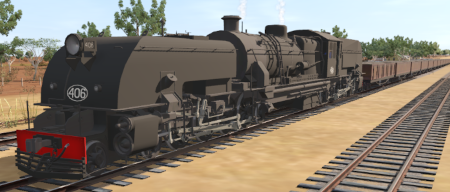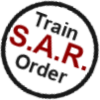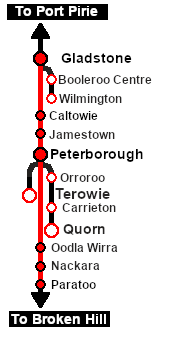SAR Scenario Gladstone Bulk Ore
m |
m |
||
| (12 intermediate revisions by one user not shown) | |||
| Line 1: | Line 1: | ||
| + | <!-- V1.0 --> | ||
<table width=1000> <!-- BEGIN Title table --> | <table width=1000> <!-- BEGIN Title table --> | ||
<tr valign="top"> | <tr valign="top"> | ||
| Line 21: | Line 22: | ||
The line from '''Port Pirie''' to '''Cockburn''' on the '''South Australia - New South Wales''' border was built in stages from 1875 to 1888 largely to capture the lead, zinc and silver ore traffic from the mines at '''Broken Hill''' just over the border in '''New South Wales'''. Because the '''SAR''' was not allowed to operate into '''New South Wales''', a private railway, the '''Silverton Tramway''', was created to carry the ore across the border. The '''SAR''' and '''Silverton Tramway''' simply swapped locos at '''Cockburn''' on the border. It was called a "tramway" to get around a NSW law banning private railways but not private tramways. Despite the title it was a fully operating heavy haul railway, and one of the most profitable in the country. | The line from '''Port Pirie''' to '''Cockburn''' on the '''South Australia - New South Wales''' border was built in stages from 1875 to 1888 largely to capture the lead, zinc and silver ore traffic from the mines at '''Broken Hill''' just over the border in '''New South Wales'''. Because the '''SAR''' was not allowed to operate into '''New South Wales''', a private railway, the '''Silverton Tramway''', was created to carry the ore across the border. The '''SAR''' and '''Silverton Tramway''' simply swapped locos at '''Cockburn''' on the border. It was called a "tramway" to get around a NSW law banning private railways but not private tramways. Despite the title it was a fully operating heavy haul railway, and one of the most profitable in the country. | ||
| − | The '''SAR''' had a monopoly on the ore traffic until 1919 when the '''NSWGR''' (New South Wales Government Railways) completed its own standard gauge (4ft 8 | + | The '''SAR''' had a monopoly on the ore traffic until 1919 when the '''NSWGR''' (New South Wales Government Railways) completed its own standard gauge (4ft 8½in) line from '''Sydney''' to '''Broken Hill''' but the '''SAR''' continued to carry the bulk of the ore because the port and smelter at '''Port Pirie''' was much closer to '''Broken Hill'''. |
| − | By 1970 the narrow gauge line from '''Port Pirie''' to '''Broken Hill''' had been converted to standard gauge and the '''Silverton Tramway''' ceased its ore hauling operations but continues to operate today providing standard gauge shunting services and | + | A variety of motive power was used on the ore trains. '''SAR Y''' class locos were originally used then the '''SAR T''' class took over until they were largely replaced by the '''SAR 406''' class locos in the 1950s. In the 1960s the '''SAR 830''' class (narrow gauge) diesel locos started appearing. |
| + | |||
| + | By 1970 the narrow gauge line from '''Port Pirie''' to '''Broken Hill''' had been converted to standard gauge and the '''Silverton Tramway''' ceased its ore hauling operations but continues to operate today providing standard gauge shunting services and loco leasing to other rail operators. The '''SAR 830''' class (standard gauge) diesels continued to haul the ore trains well into the 2000s. | ||
----- | ----- | ||
<table width=1000> <!-- BEGIN Scenario image and loco/consist table --> | <table width=1000> <!-- BEGIN Scenario image and loco/consist table --> | ||
| Line 29: | Line 32: | ||
<td width=450>[[image:SAR 406 Paratoo Loaded Ore.png|link=|alt=Loaded Ore]]</td> | <td width=450>[[image:SAR 406 Paratoo Loaded Ore.png|link=|alt=Loaded Ore]]</td> | ||
<td> | <td> | ||
| − | <table width=550> <!-- BEGIN Loco/consist sub table --> | + | <table width=550 bgcolor="black"> <!-- BEGIN Loco/consist sub table --> |
| + | <tr valign="top"> | ||
| + | <td> | ||
| + | <table width=546 bgcolor="white"> | ||
<tr valign="top"> | <tr valign="top"> | ||
<td width=75><span style="font-size: 15px; font-weight: 700; color: white; background-color: black;"> Era: </span></td> | <td width=75><span style="font-size: 15px; font-weight: 700; color: white; background-color: black;"> Era: </span></td> | ||
| Line 36: | Line 42: | ||
<tr valign="top"> | <tr valign="top"> | ||
<td><span style="font-size: 15px; font-weight: 700; color: white; background-color: black;"> Duration: </span></td> | <td><span style="font-size: 15px; font-weight: 700; color: white; background-color: black;"> Duration: </span></td> | ||
| − | <td> | + | <td>'''Peterborough: 1 hour 25 minutes (includes refuelling time)'''<br> |
| − | + | '''Gladstone: 2 hours 45 minutes'''</td> | |
</tr> | </tr> | ||
<tr valign="top"> | <tr valign="top"> | ||
<td><span style="font-size: 15px; font-weight: 700; color: white; background-color: black;"> Loco: </span></td> | <td><span style="font-size: 15px; font-weight: 700; color: white; background-color: black;"> Loco: </span></td> | ||
<td>'''[[SAR_Scenario_Rolling_Stock#SAR_400_Class|SAR 406]]''' (Garrett) on the <span style="font-weight: 700;"><span style="color: white; background-color: blue;"> Main </span> line</span> approaching '''Paratoo''' from the '''East'''<br> | <td>'''[[SAR_Scenario_Rolling_Stock#SAR_400_Class|SAR 406]]''' (Garrett) on the <span style="font-weight: 700;"><span style="color: white; background-color: blue;"> Main </span> line</span> approaching '''Paratoo''' from the '''East'''<br> | ||
| − | ''' | + | '''The [[image:Loco_Roster_Label.png|link=SAR Peterborough Division Loco Roster]] has locos available at the <span style="color: white; background-color: black;"> Peterborough Loco Depot </span>''' for an optional loco swap |
| − | *'''[[SAR_Scenario_Rolling_Stock#SAR_T_Class|SAR T 23]] | + | *'''[[SAR_Scenario_Rolling_Stock#SAR_T_Class|SAR T 23]] at <span style="color: white; background-color: black;"> Loco Sidings </span>''' |
| − | *'''[[SAR_Scenario_Rolling_Stock#SAR_T_Class|SAR T 233]] | + | *'''[[SAR_Scenario_Rolling_Stock#SAR_T_Class|SAR T 233]] at <span style="color: white; background-color: black;"> Loco Sheds </span>''' |
| − | *'''[[SAR_Scenario_Rolling_Stock#SAR_400_Class|SAR 407]] | + | *'''[[SAR_Scenario_Rolling_Stock#SAR_400_Class|SAR 407]] at <span style="color: white; background-color: black;"> Repair Shop Sheds </span>''' |
| + | </td> | ||
</tr> | </tr> | ||
<tr valign="top"> | <tr valign="top"> | ||
<td><span style="font-size: 15px; font-weight: 700; color: white; background-color: black;"> Consist: </span></td> | <td><span style="font-size: 15px; font-weight: 700; color: white; background-color: black;"> Consist: </span></td> | ||
| − | <td>Attached to '''[[SAR_Scenario_Rolling_Stock#SAR_400_Class|SAR 406]]''' | + | <td>Attached to '''[[SAR_Scenario_Rolling_Stock#SAR_400_Class|SAR 406]]''' |
| + | *23 '''[[SAR_Scenario_Rolling_Stock#TGR_CCC|CCC Gondola]]''' wagons | ||
| + | *1 '''[[SAR_Scenario_Rolling_Stock#Guard_Vans|Guard Van]]'''. | ||
</td> | </td> | ||
</tr> | </tr> | ||
| − | + | </table> | |
| − | + | ||
| − | + | ||
| − | + | ||
| − | + | ||
| − | + | ||
| − | + | ||
| − | + | ||
| − | + | ||
| − | + | ||
| − | + | ||
</td> | </td> | ||
</tr> | </tr> | ||
| Line 69: | Line 68: | ||
</tr> | </tr> | ||
</table> <!-- END Scenario image and loco/consist table --> | </table> <!-- END Scenario image and loco/consist table --> | ||
| − | <br> | + | <table bgcolor="lightcyan" width=1000> <!-- BEGIN Location Data table --> |
| + | <tr> | ||
| + | <td>[[Image:Location Index.png|link=SAR Index|alt=Location Index|Location Index]]</td> | ||
| + | <td>'''Each location in the layout has a detailed set of track diagrams that provide a variety of useful information'''<br> | ||
| + | The <span style="font-weight: 700; color: white; background-color: black;"> Getting Started </span> guide below gives a summary of what is available.<br> | ||
| + | To display this information click any [[image:Line_Index_Label.png|link=SAR_Index|Location Index]] graphic, or go to the bottom of the page for all the session links (all links will open in this window).</td> | ||
| + | </tr> | ||
| + | </table> <!-- END Location Data table --> | ||
<table cellpadding="2" bgcolor="black" width=1000> <!-- BEGIN Black border for Getting Started table --> | <table cellpadding="2" bgcolor="black" width=1000> <!-- BEGIN Black border for Getting Started table --> | ||
<tr valign="top"> | <tr valign="top"> | ||
| Line 78: | Line 84: | ||
# If you have already closed the opening message window then the first step is to pause the session by pressing the <span style="font-weight: 700; font-size: 15px; color: white; background-color: black;"> P </span> key. | # If you have already closed the opening message window then the first step is to pause the session by pressing the <span style="font-weight: 700; font-size: 15px; color: white; background-color: black;"> P </span> key. | ||
# Next locate your loco. '''Either''':- | # Next locate your loco. '''Either''':- | ||
| − | # | + | #*Open the '''Finder Tool''' (press <span style="font-weight: 700; font-size: 15px; color: white; background-color: black;"> Ctrl </span> <span style="font-weight: 700; font-size: 15px; color: white; background-color: black;"> F </span>) and type, in the '''Name''' field, the name of the loco, in this case '''SAR 406''' (or just '''406''' should be enough). Click the '''tick''' icon, '''OR''' |
| − | # | + | #*Open the '''Driver List''' (bottom left of the screen) and then scroll through the list to find the '''loco name''' ('''SAR 406''') then click the drivers '''Eye''' icon [[image:Driver_Eye.png|link=]] to take control of the loco |
# Take a few moments to get your bearings. Click [[image:Line_Index_Paratoo.png|link=SAR_Paratoo|Paratoo Data]] (this link will open in this window) to show the location details and track plans for '''Paratoo'''. In each location details page:- | # Take a few moments to get your bearings. Click [[image:Line_Index_Paratoo.png|link=SAR_Paratoo|Paratoo Data]] (this link will open in this window) to show the location details and track plans for '''Paratoo'''. In each location details page:- | ||
#*the [[image:Tab_HM_White.png|link=|75px]] tab gives an overall summary of each location with a "potted" history (where available). | #*the [[image:Tab_HM_White.png|link=|75px]] tab gives an overall summary of each location with a "potted" history (where available). | ||
| Line 121: | Line 127: | ||
# Proceed to <span style="font-weight: 700;">Peterborough <span style="color: white; background-color: #008100;"> Loop </span></span> or <span style="font-weight: 700;">Peterborough <span style="color: black; background-color: cyan;"> Yard 1 </span></span>. | # Proceed to <span style="font-weight: 700;">Peterborough <span style="color: white; background-color: #008100;"> Loop </span></span> or <span style="font-weight: 700;">Peterborough <span style="color: black; background-color: cyan;"> Yard 1 </span></span>. | ||
# Detach the loco and proceed to <span style="font-weight: 700;">Peterborough Main <span style="color: white; background-color: black;"> Loco Fuel & Water </span> Point</span> to refuel the tender with '''bunker c oil''' and '''water'''. | # Detach the loco and proceed to <span style="font-weight: 700;">Peterborough Main <span style="color: white; background-color: black;"> Loco Fuel & Water </span> Point</span> to refuel the tender with '''bunker c oil''' and '''water'''. | ||
| − | # '''Option:''' Reattach the loco, or another available loco, to the train and proceed by 09:30 to <span style="font-weight: 700;">Gladstone <span style="color: black; background-color: cyan;"> Yard </span></span>. | + | # '''Option:''' Reattach the loco, or another available loco, to the train and proceed by 09:30 to <span style="font-weight: 700;">Gladstone <span style="color: black; background-color: cyan;"> Yard </span></span>. If you are replacing the '''400 class''' with a different type of loco at '''Peterborough''' then you are advised to double-head. |
</td> | </td> | ||
<td width=100>[[image:SAR Train Order Rotated.png|100px|link=|alt=Logo]]</td> | <td width=100>[[image:SAR Train Order Rotated.png|100px|link=|alt=Logo]]</td> | ||
| Line 136: | Line 142: | ||
tr valign="top"> | tr valign="top"> | ||
<td> | <td> | ||
| + | A summary of the facilities and product loads at all locations along the line is provided in the link [[Image:SAR_PortPirie-BrokenHill_Line.png|link=SAR Port Pirie-Broken Hill|alt=Port Pirie-Broken Hill Line|Show Port Pirie-Broken Hill Line]] | ||
*Fuel oil level is low, but sufficient to reach '''Peterborough''' where it can be refilled | *Fuel oil level is low, but sufficient to reach '''Peterborough''' where it can be refilled | ||
*Water is very low and you will need to refill either here at '''Paratoo''' or at '''Nackara''' | *Water is very low and you will need to refill either here at '''Paratoo''' or at '''Nackara''' | ||
Latest revision as of 20:14, 10 May 2024
| 5 Paratoo to Peterborough Bulk Ore Paratoo to Gladstone Bulk Ore |
||
| A scenario in the SAR Peterborough Base Session | ||
| Express bulk ore freight from Broken Hill to Port Pirie. |
The Historical Bit
The line from Port Pirie to Cockburn on the South Australia - New South Wales border was built in stages from 1875 to 1888 largely to capture the lead, zinc and silver ore traffic from the mines at Broken Hill just over the border in New South Wales. Because the SAR was not allowed to operate into New South Wales, a private railway, the Silverton Tramway, was created to carry the ore across the border. The SAR and Silverton Tramway simply swapped locos at Cockburn on the border. It was called a "tramway" to get around a NSW law banning private railways but not private tramways. Despite the title it was a fully operating heavy haul railway, and one of the most profitable in the country.
The SAR had a monopoly on the ore traffic until 1919 when the NSWGR (New South Wales Government Railways) completed its own standard gauge (4ft 8½in) line from Sydney to Broken Hill but the SAR continued to carry the bulk of the ore because the port and smelter at Port Pirie was much closer to Broken Hill.
A variety of motive power was used on the ore trains. SAR Y class locos were originally used then the SAR T class took over until they were largely replaced by the SAR 406 class locos in the 1950s. In the 1960s the SAR 830 class (narrow gauge) diesel locos started appearing.
By 1970 the narrow gauge line from Port Pirie to Broken Hill had been converted to standard gauge and the Silverton Tramway ceased its ore hauling operations but continues to operate today providing standard gauge shunting services and loco leasing to other rail operators. The SAR 830 class (standard gauge) diesels continued to haul the ore trains well into the 2000s.
 |
|
Tutorial:
|
|
|
| Links: All links will open in this window | ||||||||
 Session Scenarios |
 Location List |
 Drive Tutorial |
 Rolling Stock |
 Loco Roster |
 Active Industries |
|||
This page was created by Trainz user pware in February 2021 and was last updated as shown below.


